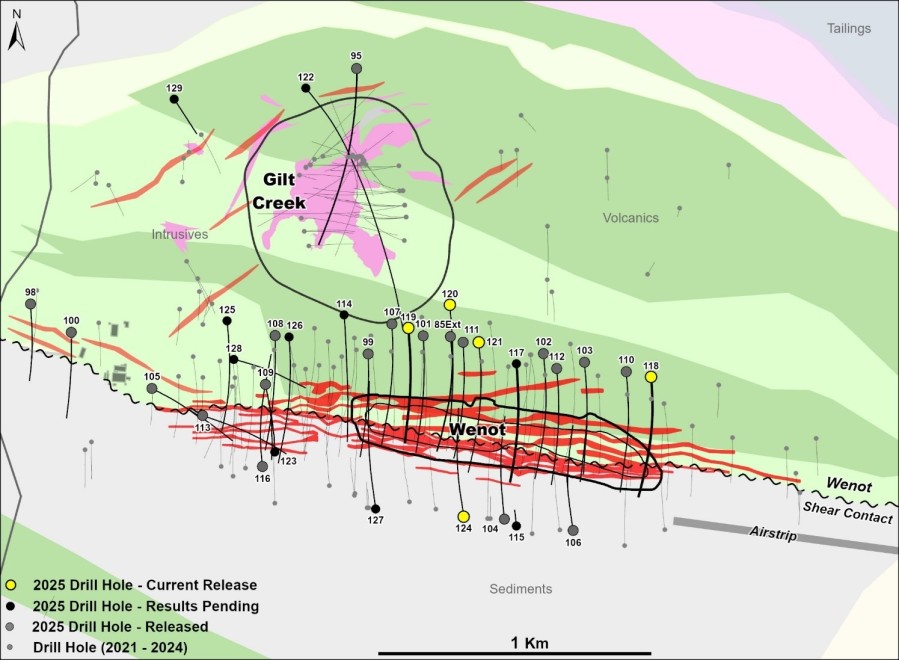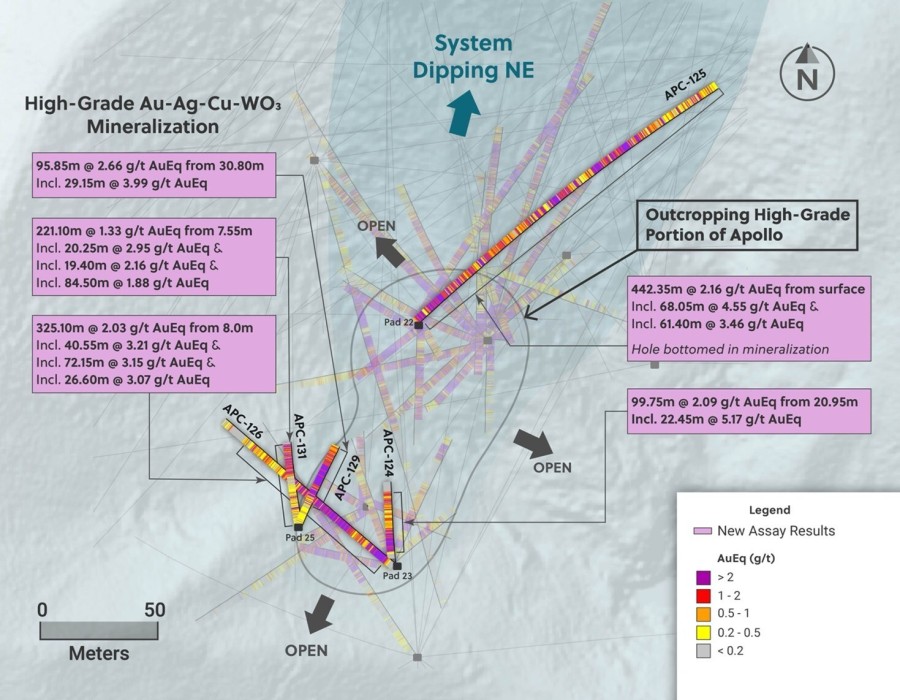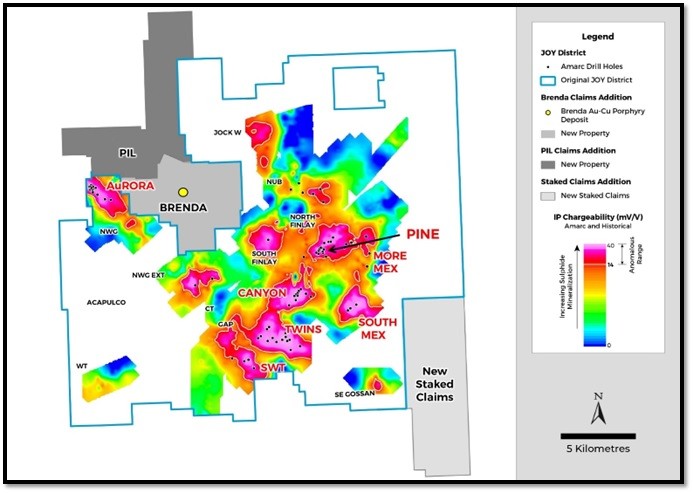VANCOUVER, British Columbia, Nov. 21, 2017 (GLOBE NEWSWIRE) -- Gold Standard Ventures Corp. (TSX:GSV) (NYSE AMERICAN:GSV) (“Gold Standard” or the “Company) today announced results from 11 of 19 completed reverse-circulation (RC) and core holes at the Pinion oxide gold deposit on its 100%-owned/controlled Railroad Project in Nevada’s Carlin Trend (please go to the following link - Click Here). These drill holes are a portion of Gold Standard’s 2017 US$15.5 million program which includes up to 48,800 m of RC and core drilling in 117 holes (see February 2, 2017 news release).
The Pinion drilling was designed to (1) upgrade and potentially add to resources by reducing drill spacing in critical portions of the deposit and (2) expand drill coverage near the margins of the current pit design for possible resource additions.
All 11 drill holes intersected oxidized and altered multi-lithic dissolution collapse breccia (mlbx), the principal Pinion host rock, and seven of the holes returned significant, higher-grade intercepts greater than one gram per tonne. Results include 56.4m of 1.68 g Au/t in PIN17-02, 42.7m of 1.23 g Au/t in PIN17-10, 15.2m of 1.66 g Au/t in PIN17-04 and 32.0m of 0.89 g Au/t in PIN17-05. In most instances, the new results either confirm or outperform the expectations in the current resource estimate block model.
Jonathan Awde, CEO and Director of Gold Standard commented: “We are pleasantly surprised by our Pinion infill drilling success which appears to be adding resource ounces at better than expected grades. We think these new results could make a valuable contribution to the Preliminary Economic Assessment now in progress. Pinion is no longer the small deposit of uncertain grade and metallurgy that we acquired four years ago. Overall, we are excited by the impact this year’s drill program could have on our valuation. There are still more than 37 drill holes to be reported on and we are hopeful that we will be able to report another new discovery from this program.”
Key Highlights
- At the Pinion North Zone, PIN17-02 intersected 56.4m of 1.68 g Au/t, including 38.1m of 2.32 g Au/t; PIN17-04 intersected 15.2m of 1.66 g Au/t including 10.6m of 2.17 g Au/t; and PIN17-01 intersected 22.8m of 0.80 g Au/t. All three drill holes appear to outperform the resource block model in this portion of the deposit and demonstrate the continuity of gold mineralization, with drill hole PIN17-01 extending the higher-grade (>1.0 g Au/t) beyond the current margins of the Pinion pit design.
- In the Pinion Main Zone, PIN17-10 intersected 42.7m of 1.23 g Au/t including a higher-grade interval of 22.8m of 1.92 g Au/t; and PIN17-05 intersected 32.0m of 0.89 g Au/t including 12.2m of 1.66 g Au/t. Both drill holes appear to outperform the resource block model in this portion of the deposit.
- Results from drill holes PIN17-05, -06, -07, -08, -09 and -10 confirm the tenor and grade of the block model in the southern portion of the Main Zone and extend mineralization beyond the current margins of the Pinion pit design. Drill hole PIN17-12, a metallurgical core hole, also appears to outperform the resource block model.
Pinion drill results are as follows:
| Drill Hole | Method | Azimuth | Incl. | TD (m) | Intercept (m) | Thickness (m) | Grade (g Au/t) |
| PIN17-01 | RC | -90 | 83.8 | 25.9 – 47.2 | 21.3 | 0.59 | |
| 61.0 – 83.8 | 22.8 | 0.80 | |||||
| PIN17-02 | RC | -90 | 152.4 | 10.7 – 67.1 | 56.4 | 1.68 | |
| Including | 13.7 – 51.8 | 38.1 | 2.32 | ||||
| 79.3 – 80.8 | 1.5 | 0.20 | |||||
| 96.0 – 99.1 | 3.1 | 0.40 | |||||
| 123.5 – 128.1 | 4.6 | 0.40 | |||||
| PIN17-03 | Core | 270 | -83 | 129.5 | Assays pending | ||
| PIN17-04 | RC | 090 | -70 | 152.4 | 79.3 – 94.5 | 15.2 | 1.66 |
| Including | 79.3 – 89.9 | 10.6 | 2.17 | ||||
| 123.4 – 128.0 | 4.6 | 0.36 | |||||
| PIN17-05 | RC | -90 | 70.1 | 12.2 – 44.2 | 32.0 | 0.89 | |
| Including | 22.9 – 35.1 | 12.2 | 1.66 | ||||
| PIN17-06 | RC | -90 | 53.4 | 6.1 – 25.9 | 19.8 | 0.75 | |
| Including | 7.6 – 12.2 | 4.6 | 2.13 | ||||
| PIN17-07 | RC | -90 | 79.3 | 24.4 – 32.0 | 7.6 | 1.22 | |
| PIN17-08 | RC | -90 | 91.5 | 29.0 – 38.1 | 9.1 | 0.97 | |
| 45.7 – 54.8 | 9.1 | 0.50 | |||||
| 86.8 – 89.9 | 3.1 | 0.33 | |||||
| PIN17-09 | RC | -90 | 106.7 | 0 – 3.1 | 3.1 | 0.39 | |
| 54.9 – 73.2 | 18.3 | 0.40 | |||||
| 102.1 – 103.6 | 1.5 | 0.15 | |||||
| PIN17-10 | RC | 090 | -55 | 122.0 | 0 – 42.7 | 42.7 | 1.23 |
| Including | 13.7 – 36.5 | 22.8 | 1.92 | ||||
| 74.6 – 77.7 | 3.1 | 0.46 | |||||
| PIN17-11 | RC | 090 | -60 | 100.6 | 50.3 – 68.6 | 18.3 | 0.78 |
| 94.5 – 100.6 | 6.1 | 0.42 | |||||
| PIN17-12 | Core | 050 | -74 | 91.4 | 12.2 - 53.8 | 41.5 | 0.85 |
| Including | 41.2 - 53.8 | 12.6 | 1.58 | ||||
| PIN17-13 | Core | 047 | -77 | 199.7 | Assays pending | ||
| PIN17-14 | RC | 090 | -65 | 280.5 | Assays pending | ||
| PIN17-15 | RC | 090 | -70 | 213.4 | Assays pending | ||
| PIN17-16 | RC | 060 | -75 | 166.2 | Assays pending | ||
| PIN17-17 | RC | -90 | 68.6 | Assays pending | |||
| PIN17-18 | RC | 090 | -76 | 106.7 | Assays pending | ||
| PIN17-19 | RC | -90 | 68.6 | Assays pending | |||
** Gold intervals reported in this table were calculated using a 0.14 g Au/t cutoff. Weighted averaging has been used to calculate all reported intervals. True widths are estimated at 70-90% of drilled thicknesses.
-
Mac Jackson, Gold Standard’s Vice President of Exploration stated: “We are off to a great start in our development drill program at Pinion with several greater than 1 g Au/t oxide intercepts well above the 0.62 g Au/t average grade of the deposit. These results suggest local structural control to higher-grade mineralization within the extensive multi-lithic breccia host horizon, a common grade distribution pattern on the Carlin Trend. As we progress with our infill program, we hope to continue to better define and extend these greater than 1 g Au/t oxide gold zones, increasing the average grade of the Pinion deposit.”
Sampling Methodology, Chain of Custody, Quality Control and Quality Assurance
All sampling was conducted under the supervision of the Company’s project geologists and the chain of custody from the project to the sample preparation facility was continuously monitored. Core was cut at the company’s facility in Elko and one quarter was sent to the lab for analysis and the remaining material retained in the original core box. A blank or certified reference material was inserted approximately every tenth sample. The core and RC samples were delivered to ALS Minerals preparation facility in Elko, NV where they were crushed and pulverized. Resulting sample pulps were shipped to ALS Minerals certified laboratory in Sparks, NV or Vancouver, BC. Pulps were digested and analyzed for gold using fire assay fusion and an atomic absorption spectroscopy (AAS) finish on a 30 gram split. All other elements were determined by ICP analysis. Data verification of the analytical results included a statistical analysis of the standards and blanks that must pass certain parameters for acceptance to insure accurate and verifiable results.
Drill hole deviation was measured by gyroscopic down hole surveys that were completed on all holes by International Directional Services or Minex of Elko, NV. Final collar locations are surveyed by differential GPS by Apex Surveying, LLC of Spring Creek, Nevada.
The scientific and technical content contained in this news release have been reviewed, verified and approved by Steven R. Koehler, Gold Standard’s Manager of Projects, BSc. Geology and CPG-10216, a Qualified Person as defined by NI 43-101, Standards of Disclosure for Mineral Projects.
ABOUT GOLD STANDARD VENTURES – Gold Standard is an advanced stage gold exploration company focused on district scale discoveries on its Railroad-Pinion Gold Project, located within the prolific Carlin Trend. The 2014 Pinion and Dark Star gold deposit acquisitions offer Gold Standard a potential near-term development option and further consolidates the Company’s premier land package on the Carlin Trend. The Pinion deposit now has an NI43-101 compliant resource estimate consisting of an Indicated Mineral Resource of 31.61 million tonnes grading 0.62 g/t Au, totaling 630,300 ounces of gold and an Inferred Resource of 61.08 million tonnes grading 0.55 g/t Au, totaling 1,081,300 ounces of gold, using a cut-off grade of 0.14 g/t Au. The Dark Star deposit, 2.1 km to the east of Pinion, has a NI43-101 compliant resource estimate consisting of an Indicated Mineral Resource of 15.38 million tonnes grading 0.54 g/t Au, totaling 265,100 ounces of gold and an Inferred Resource of 17.05 million tonnes grading 1.31 g/t Au, totaling 715,800 ounces of gold, using a cut-off grade of 0.2 g Au/t. The North Bullion deposit, 7 km to the north of Pinion, has a NI43-101 compliant resource estimate consisting of an Indicated Mineral Resource of 2.92 million tonnes grading 0.96 g/t Au, totaling 90,100 ounces of gold and an Inferred Resource of 10.97 million tonnes grading 2.28 g/t Au, totaling 805,800 ounces of gold, using a cut-off grade of 0.14 g Au/t for near surface oxide and 1.25 to 2.25 g Au/t for near surface sulfide and underground sulfide respectively.





